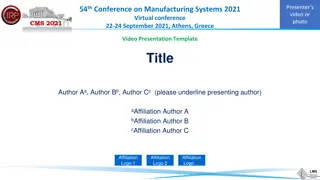
Understanding DNA Replication Process in Molecular Biology
DNA replication is a vital biological process that produces identical copies of DNA molecules, essential for biological inheritance, cell division, growth, and repair of tissues. Enzymes play a crucial role in catalyzing various steps, including helicase unwinding DNA, DNA polymerases synthesizing new DNA, and ligase joining DNA fragments. The process involves stages like initiation, elongation, and termination, ensuring accurate replication of DNA strands.
Download Presentation

Please find below an Image/Link to download the presentation.
The content on the website is provided AS IS for your information and personal use only. It may not be sold, licensed, or shared on other websites without obtaining consent from the author. If you encounter any issues during the download, it is possible that the publisher has removed the file from their server.
You are allowed to download the files provided on this website for personal or commercial use, subject to the condition that they are used lawfully. All files are the property of their respective owners.
The content on the website is provided AS IS for your information and personal use only. It may not be sold, licensed, or shared on other websites without obtaining consent from the author.
E N D
Presentation Transcript
DNA DNA Replication Replication In molecular biology, DNA replication is the biological process of producing two identical replicas of DNA from one original DNA molecule. DNA replication occurs in all living organisms acting as the most essential part for biological inheritance. This is essential for cell division during growth and repair of damaged tissues, while it also ensures that each of the new cells receives its own copy of the DNA.
DNA replication would not occur without enzymes that catalyze various steps in the process. DNA replication would not occur without enzymes that catalyze various steps in the process. 1) 1) DNA DNA helicase helicase - unwinds and separates double stranded . 2) DNA primase - a type of RNA polymerase that generates RNA primers. 3) DNA nucleotides to leading and lagging DNA strands. DNA polymerases polymerases - synthesize new DNA molecules by adding 4) 4) Topoisomerase prevent the DNA from becoming tangled or supercoiled. Topoisomerase or or DNA DNA Gyrase Gyrase - unwinds and rewinds DNA strands to 5) 5) Exonucleases end of a DNA chain. Exonucleases - group of enzymes that remove nucleotide bases from the 6) 6) DNA bonds between nucleotides. DNA ligase ligase - joins DNA fragments together by forming phosphodiester
Stages Stages of DNA replication of DNA replication 1 1- -Initiation Initiation DNA synthesis is initiated at particular points within the DNA strand known as origins are specific coding regions. There are multiple origin sites, and when replication of DNA begins, these sites are referred to as replication origins , which replication forks forks.
2 2- -Elongation Elongation Once the DNA Polymerase has attached to the original, unzipped two strands of DNA (i.e. the template synthesising the new DNA to match the templates. by adding free nucleotides to the 3 3 end template strands), it is able to start end. .
3 3- -Termination Termination The process of expanding the new DNA strands continues until there is either no more DNA template left to replicate (i.e. at the end of the chromosome), or two replication forks meet and subsequently terminate terminate. .
Protein Protein Synthesis Synthesis This amazing artwork shows a process that takes place in the cells of all living things: the production of proteins. This process is called protein synthesis, and it actually consists of two processes transcription and translation. In eukaryotic cells, transcription takes place in the nucleus. During transcription, DNA is used as a template to make a molecule of messenger RNA (mRNA). The molecule of mRNA then leaves the nucleus and goes to a ribosome in the cytoplasm, where translation occurs. During translation, the genetic code in mRNA is read and used to make a protein. These two processes are summed up by the central dogma of molecular biology: DNA RNA Protein.
Transcription Transcription is the first part of the central dogma of molecular biology: DNA RNA. It is the transfer of genetic instructions in DNA to mRNA. During transcription, a strand of mRNA is made to complement a strand of DNA.
Steps Steps of Transcription of Transcription 1) Transcription takes place in three steps: initiation, elongation, and termination. The steps are illustrated in the figure below. 2) 2) Initiation enzyme RNA polymerase binds to a region of a gene called the promoter. This signals the DNA to unwind so the enzyme can read the bases in one of the DNA strands. Initiation: : is the beginning of transcription. It occurs when the 3) 3) Elongation Elongation :is the addition of nucleotides to the mRNA strand. 4) 4) Termination complete, and it detaches from DNA. Termination: : is the ending of transcription. The mRNA strand is
Translation Translation Translation is the second part of the central dogma of molecular biology: RNA Protein. It is the process in which the genetic code in mRNA is read to make a protein.





















